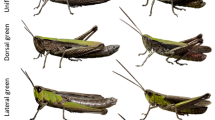Summary
The mechanism of the genetic control of wing form determination of the small brown planthopperLaodelphax striatellus was analyzed by selection and crossing experiments. The selection experiment for brachypterous and macropterous forms for 13 generations showed that the wing form is under some genetic control. The crossing experiment showed that the wing form polymorphism was not a simple Mendelian character but was under polygenic control. The data from the crossing experiment were applied to the liability method for the quantitative genetics by Falconer (1981). The analysis suggested that wing form determination was a threshold character under polygenic control, and the estimated minimum number of loci concerned was 2.07. The realized heritability estimated from the data of selection experiment was 0.36 for macroptery. On the other hand, the heritability in broad sense estimated on the basis of the variance of F1 and F2 in crossing experiment was 0.81.
Similar content being viewed by others
References
Falconer, D. S. (1981)Introduction to Quantitative Genetics (2nd ed.). Longman, London.
Harrison, G. R. (1980) Dispersal polymorphisms in insects.Ann. Rev. Ecol. Syst. 11: 95–118.
Honěk, A. (1987) Wing polymorphism inPyrrhocoris apterus (Heteroptera: Pyrrhocoridae): penetrace of recessive macropterous homozygotes and duration of larval development.Genetica. 73: 211–215.
Iwanaga, K., S. Tojo and N. Nagata (1985) Immigration of the brown planthopperNilaparvata lugens, exhibiting various responses to density in relation to wing morphism.Ent. Exp. Appl. 38: 101–108.
Kisimoto, R. (1956) Effect of crowding during the larval period on the determination of the wing-form of an adult planthopper.Nature 178: 641–642.
Kisimoto, R. (1959) Brachypter and macropter of planthoppers.Shokubutsu-boeki 13: 298–302 (In Japanese).
Mather, K. and J. L. Jinks (1972)Biometrical Genetics (2nd ed.). Chapman and Hall, New York.
Mahmud, F. S. (1980) Alary polymorphism in the small brown planthopperLaodelphax striatellus (Homoptera: Delphacidae).Ent. Exp. Appl. 28: 47–53.
Palmer, J. O. and H. Dingle (1986) Direct and correlated response to selection among life-history traits in milkweed bugs (Oncopeltus fasciatus).Evolution 40: 767–777.
Roff, D. A. (1986a) The genetic basis of wing dimorphism in the sand cricket,Gryllus firmus and its relevance to the evolution of wing dimorphisms in insects.Heredity,57: 221–231.
Roff, D. A. (1986b) Evolution of wing polymorphism and its impact on life cycle adaptation in insects. 204–221. In F. Tailor and R. Karbaneds (eds)The Evolution of Insect Life Cycle. Springer-Verlag.
Solbreck, C. (1986) Wing and flight muscle polymorphism in a lygaeid bug,Horvathiolus gibbicollis: determinants and life history consequences.Ecol. Ent. 11: 435–444.
Zera, A. J., D. J. Innes and M. E. Saks (1983) Genetic and environmental determinants of wing polymorphism in the waterstriderLimnoporus canaliculatus.Evolution 37: 513–522.
Author information
Authors and Affiliations
Rights and permissions
About this article
Cite this article
Mori, K., Nakasuji, F. Genetic analysis of the wing-form determination of the small brown planthopper,Laodelphax striatellus (Hemiptera: Delphacidae). Res Popul Ecol 32, 279–287 (1990). https://doi.org/10.1007/BF02512563
Issue Date:
DOI: https://doi.org/10.1007/BF02512563




